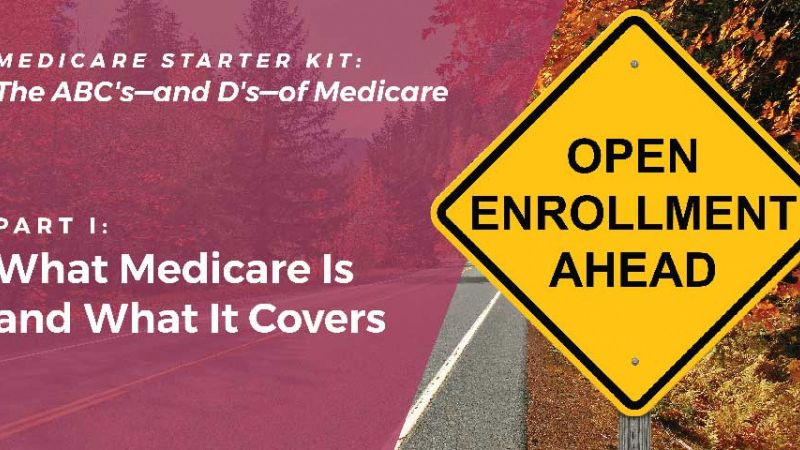Medicare options and supplements can often be confusing, especially if you have never gone through the process before. With that in mind, our team at Medical Guardian decided to put a Medicare Starter Kit together to help seniors and their loved ones better plan for Medicare enrollment this year. We’ve broken down the costs, features, and deadlines for Medicare enrollment, and offer you an inside look at what Medicare is and the coverage it offers.
All of the facts and figures we’ve included below have been taken directly from Medicare.gov and are current as of 2018.
What is Medicare?
Medicare is the national health insurance program for American citizens age 65 and older, younger individuals with certain disabilities, and those with end-stage permanent kidney failure. Medicare is funded through the Social Security and Medicare taxes that are taken out of your income, premiums paid by users enrolled in Medicare programs, and through a portion of the federal budget.
Medicare is broken up into four different parts, with each part covering different areas of health care:
-
Medicare Part A is hospital insurance. When enrolled in Medicare Part A, hospital expenses like inpatient hospital visits, skilled nursing care in a nursing facility, hospice, and in-home health care services are covered.
-
Medicare Part B is health insurance. When enrolled in Medicare Part B, users receive coverage for necessary medical services including doctor’s office visits, lab work, x-rays, outpatient care and surgery, medical care, and preventative medical services. Part B also covers medically necessary durable equipment like wheelchairs and walkers.
-
Medicare Part C is also referred to as Medicare Advantage, a type of Medicare plan offered through Medicare-approved private companies that include all Medicare Part A and Medicare Part B coverage. Medicare Advantage plans offer access to HMOs, PPOs, private fee-for-service plans, and special needs plans and can help reduce overall medical costs for some users.
-
Medicare Part D is prescription drug coverage. Each Part D plan includes different lists of approved drugs that have different associated costs.
What does Medicare cover?
Medicare offers comprehensive health care coverage but may not cover every test, item, or service. This is why it is crucial to pay attention during the Medicare enrollment period in order to make sure that you enroll in the right care plan for your needs.
As outlined above, Medicare Part A covers hospital visits and related services, Medicare Part B covers medical services like visiting a doctor, exams, check-ups, and preventative screening services, and Medicare Part D covers prescription drugs. Medicare Advantage (Medicare Part C) plans include a combination of services offered through Medicare Parts A, B, and D.
What is not covered by Medicare?
Medicare Part A and Medicare Part B do not include coverage for services that are often considered elective. Some of these services include dental care and dentures, cosmetic surgery, hearing aids, or eye exams for glasses. If you pay the additional premium, some Medicare Advantage plans, however, will include these services.
To determine whether or not a particular service is offered through Medicare, visit Medicare.gov’s coverage checker to see if your treatment is covered.
Exams and Checkups
Medicare Part B includes an annual Wellness Check-Up. Each year, you will need to make an appointment with your primary care provider, or PCP, to get a physical and update your prevention plan for early detection of certain diseases. Early detection testing looks to prevent sickness by examining your current health as well as your risk factors for specific conditions and diseases.
When you switch over to Medicare, you may also have to switch doctors if your General Practitioner does not accept Medicare. A new doctor will ask you for your medical history, as well as your family health history. They may also discuss end-of-life care scenarios or plan a 5-10 year screening schedule for specific diseases. Your doctor will likely provide advice or referrals to other physicians in order to maintain or improve your health. If you have been advised to receive additional testing or have been referred to a specialist, be sure to ask whether they accept Medicare coverage before booking your appointment so that you won’t get stuck with a big bill afterward.
Early Detection
Medicare coverage includes a “Welcome to Medicare” preventive visit with a physician, and you will have one year to schedule it after you first enroll in Medicare Part B. The Welcome visit not only includes a physical, it also provides you with a health risk assessment, takes a look at your mobility, routine flu, and pneumococcal vaccines, and a snapshot of the overall state of your health.
Early detection of certain conditions, like cancer or heart disease, is included with your Medicare coverage. The “Welcome to Medicare” preventive visit is a one-time-only appointment for new Medicare members. Medicare Part B covers this appointment, but must occur within the first twelve months of enrollment in Part B. Keeping illness at bay and staying healthy are both important for preventative care.
After your “Welcome to Medicare” appointment, subsequent preventative services will have their own set of rules regarding eligibility and frequency. Check your Medicare card and speak with your provider for more details.
Going to the Doctor on Medicare
Do you need to see a cardiologist? A pulmonologist? An allergist? Before you make the appointment, always double check that the doctor you want to see accepts Medicare and is considered a participating physician. These doctors typically charge less out-of-pocket fees and wait until Medicare pays their portion of the bill before billing you.
You can find eligible providers on the Medicare.gov website, along with hospitals, dialysis facilities and more.
Time For Medicare Coverage
Now that you understand the basics of Medicare, the next step is finding out if you are eligible for coverage. Once you turn 65, you have a seven-month period to enroll before you experience a gap in medical insurance coverage or have to pay a penalty.

